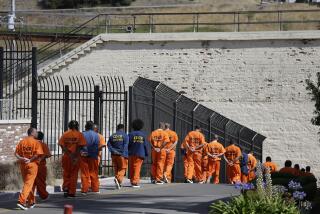The truth about ‘early release’
Both Gov. Jerry Brown’s ill-considered plan for complying with a court-ordered prison population cap by contracting out for inmate beds, and Senate President Pro Tem Darrell Steinberg’s much smarter plan to control the flow of new inmates into prison, are based on the desire to prevent, at almost all costs, the early release of inmates.
And that is understandable. California’s 33 prisons are overpopulated by about 9,600 felons, according to courts that have ordered the number of inmates to be reduced to 137.5% of design capacity by Dec. 31. The prospect of that many convicted criminals being released onto the streets in a single wave is frightening.
But Californians should understand that their leaders’ motivation for resisting early release is based at least as much on political as criminological facts. The prison doors will not swing open. There will be no new wave of released felons.
It’s no surprise that politicians are nervous about the term “early release.” Brown, a Democrat, faces reelection next year, and former Lt. Gov. Abel Maldonado, a Republican, launched his campaign for Brown’s job by criticizing the governor for jeopardizing public safety. That leaves Brown and legislative Democrats eager to emphasize (accurately) that until now they have not released any prison inmates early, and to show that they will not accept any early releases as they go forward, despite the reduction order that results from more than a decade of litigation over prison overcrowding and an unconstitutionally low quality of inmate mental health care and medical care.
But in making their public statements and presenting their plans, Brown and Democratic leaders are failing to point out that felons already leave prison in large numbers and return to their home communities in a consistent, steady flow.
Before October 2011, when AB 109 “realignment” took effect and transferred responsibility for some felons from the state to counties, about 9,600 already were leaving state prison — every month.
Of that number, some departures were deaths. But the vast majority were inmates who left prison alive and went back to their old neighborhoods. All the while, crime rates in the state plunged.
It would be folly to argue that the paroled felon population posed no danger; the return was and continues to be a burden, mostly on the communities already struggling with gang crime and drugs, and the burden is all the heavier because California for years offered only the most cursory drug treatment, mental health care, education and other rehabilitative programs in prison.
But while returning prisoners certainly present a challenge, we can’t say we haven’t seen this kind of release before. It is not new. It is the norm. California has handled it. Crime continues to decline.
Since AB 109 realignment took effect, the number of inmates released monthly from state prisons has plummeted to about 3,000. Add back those who are now getting out of local jails after being incarcerated for nonserious, nonviolent and non-sex-related felonies, and the number of monthly felon releases is about where it was before.
Even though 9,600 is the number by which the prison population must shrink by the end of the year, neither Brown nor lawmakers nor anyone else closely following the situation has been fooled into believing that most of those people would actually be set free any earlier than they would have been otherwise. Brown’s previous draft plan contemplated transfers of eligible inmates to fire camps and others to county jail space, with only about 1,000 released “early.”
And if the state were required to release that many prisoners early, it would select those who would be released not to the streets but to nursing homes and hospice care, because so many of the longest-serving prisoners are elderly, infirm and well past the age at which studies show even the most hardened criminals commit crimes.
And just how “early” would they be released? In most cases, it is a matter of a few months earlier than they otherwise would leave prison. By adjusting credits earned for good behavior and for work while incarcerated, an inmate who might otherwise serve 18 months could, for example, be paroled or locally supervised after 12 to 15.
That is nothing new or different. From the time California abolished most indeterminate sentencing in 1977, prisoners have earned time off the incarceration portion of their sentences for good behavior and for working. Lawmakers have adjusted such credits many times without calling the result “early release,” and without increasing the danger posed by the return of felons to their families and neighborhoods.
None of this is to say that an earlier return of prisoners is inherently good, especially when they have had insufficient access to treatment or training while they have been locked up and come out as dangerous as when they went in.
But early release is not the looming prison challenge that Californians must address. The state has to get better at using its prison space for the most serious criminals and at using its resources in the community to correct the behavior of offenders who are amenable to change, while protecting the population from predators. Steinberg’s plan moves California in that direction, and it has the added benefit of blocking early releases. Brown’s sacrifices smart planning and millions of dollars in resources in the name of delaying for a short period a few inmate releases that in the end pose a far smaller problem than he lets on.
More to Read
A cure for the common opinion
Get thought-provoking perspectives with our weekly newsletter.
You may occasionally receive promotional content from the Los Angeles Times.






